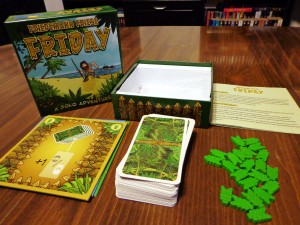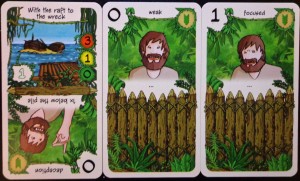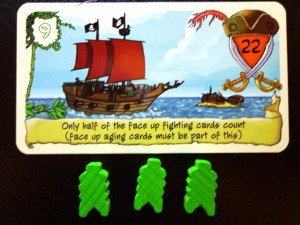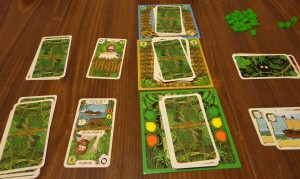It’s Friday. The kids (AKA Dad’s Review Crew) are out for the day and thus I am unable to unwind with them by playing some of the board games stacked next to my desk, which are pending to be reviewed. One of them stuck out however, “Friday” ironically, and I decided that now would be a good time to take a look at it.
Friday is a one player solo adventure that tasks the player with surviving on a deserted island. The player will be trying to fend off hazards, acquire new fighting cards by beating said hazards, and survive the pirates who act as “final bosses” for lack of better term. Let’s take a quick look at the rules and gameplay before we head into the review.
Components
Cards – There are Fighting Cards, Aging Cards, Hazard Cards, Step Cards, and Pirate Cards.
Life Points – These green pieces track your life points as you progress through the game.
Storage Boards – These boards organize the various decks you’ll be using throughout the game. There’s a board for your Fighting Cards, a board for the Hazard Cards, and a board for the Aging Cards.
Setup & Gameplay
Setup can be a little overwhelming until you get used to all of the different cards that are available in the game. To keep the review moving, I’ll simply point you to the manual…check out page three on the following link to see the game setup.
The general idea of the game is to use your starting Fighting Cards, which are pretty bad, to defeat and acquire Hazard Cards as they come up. Hazard Cards are split in two…one end is a hazard, which you’ll address as the Hazard Cards are drawn, and the other end acts as a Fighting Card, which you add to your Fighting Card Deck and use after beating the hazard. The values and bonuses on the Fighting Card end of a Hazard Card are much better, so you’ll be trying to beat hazards and add as many as you can to your starting Fighting Deck. Confused yet? I was at first as well.
At the start of a turn, you’ll draw two Hazard Cards and pick one, discarding the other. The value in white is how many Fighting Cards you can draw to try and defeat the hazard in order to add it to your Fighting Card Deck. The difficulty of the hazard depends on the color phase you are in (Green, Yellow, or Red). The difficulty of the hazard goes up as you reach the later phases. If the values on your Fighting Cards are greater or equal to the difficulty value of the Hazard Card, you place it into your Fighting Card Deck and use the Fighting Card portion of it from then on. If you lose, you’ll have to pay life points.
Aging Cards (which are generally negative) are added to your Fighting Card Deck as you cycle through it to represent your deteriorating condition. You can remove Fighting Cards (preferably the bad ones) from your Fighting Card Deck at a cost of life points.
You’ll continue cycling through the Hazard Cards and the Fighting Cards, trying to build your Fighting Card Deck and make it to the end of the red phase. After that, you’ll have to defeat both pirate cards which act in the same manner as hazards. You’ll either beat them or run out of life.
I skipped over some things and didn’t go into a lot of detail…if you want learn more, check out the manual by following the link that I provided earlier.
The Review
I’m still not sure what to make of Friday. I played it twice and lost badly both times, mainly due to some really bad draws. I constantly lost against the hazards, which prevented me from acquiring better Fighting Cards and caused me to lose life. While you can choose between two Hazard Cards, the weaker hazard won’t help you if you are continuously drawing zero and negative Fighting Cards. I haven’t decided yet if this game is a challenge to be conquered, or if the deck is stacked against you unfairly and thus shouldn’t be bothered with ever again.
The cards are pretty and the components are sturdy, so no complaints in that department. The learning curve is moderate…it took me a few hours to understand what the game’s instructions were telling me and how all of the cards worked together and interacted. There are ways to increase or decrease the difficulty, with or without the manual’s help (by removing some of the really negative Aging Cards…by reducing the life point penalty for removing Aging Cards…be creative).
There is a little bit of strategy, as you’ll be able to sacrifice life to remove bad Fighting Cards or draw more Fighting Cards during a hazard challenge that isn’t going your way. I found myself trying to find the best balance between sacrificing life to remove bad cards and keeping enough in reserve to account for all of the hazard challenges I was losing. Once you find yourself falling behind, you won’t be able to recoup as the difficulty level ramps up in the yellow phase.
Honestly, I found the game too luck based for my taste. Those who just want a fun diversion might get a kick out of this, but I found myself wanting to spend my kid-free time earning skulls on Orcs Must Die! 2 as opposed to playing this.
Final Verdict: 4/10




